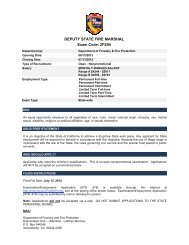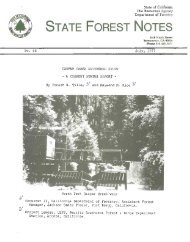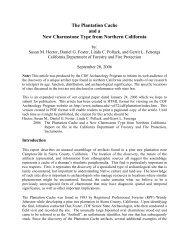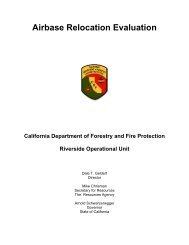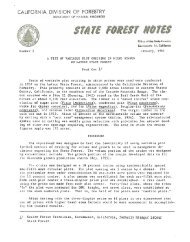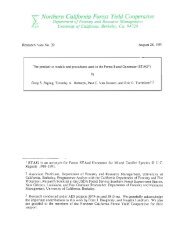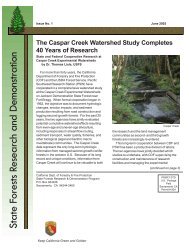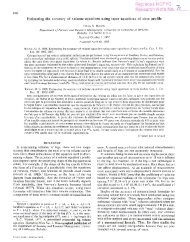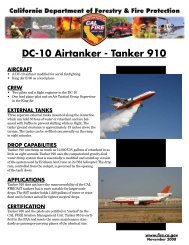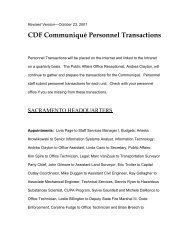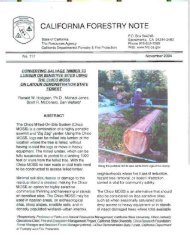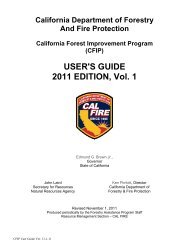Communiqué - Cal Fire - State of California
Communiqué - Cal Fire - State of California
Communiqué - Cal Fire - State of California
You also want an ePaper? Increase the reach of your titles
YUMPU automatically turns print PDFs into web optimized ePapers that Google loves.
Safeguarding <strong>Cal</strong>ifornia’s Water<br />
CAL FIRE Protects Water Quality Th rough Timber Harvest Monitoring<br />
By Pete Caff erata, Forest Hydrologist, Forest Practice Program, Sacramento Headquarters<br />
Water is <strong>of</strong>ten considered <strong>Cal</strong>ifornia’s most<br />
important and controversial resource.<br />
Nearly 85 percent <strong>of</strong> <strong>Cal</strong>ifornia’s average<br />
annual run<strong>of</strong>f is produced from forested<br />
watersheds. Improper logging practices<br />
have the potential to adversely impact<br />
water quality.<br />
Many <strong>of</strong> the modern Forest Practice Rules<br />
(FPRs) developed by the Board <strong>of</strong> Forestry<br />
and <strong>Fire</strong> Protection to regulate logging<br />
on non-federal timberlands were passed<br />
to protect water quality from improper<br />
logging practices that regularly occurred<br />
before the mid-1970’s. The FPRs are<br />
designed to keep sediment out <strong>of</strong> streams<br />
and retain trees along streams for shade<br />
and wildlife values.<br />
CAL FIRE’s Forest Practice Program<br />
regulates logging on approximately 7.3<br />
million acres <strong>of</strong> non-federal commercial<br />
timberlands in <strong>Cal</strong>ifornia. CAL FIRE’s Forest<br />
Practice Inspectors enforce the <strong>Cal</strong>ifornia<br />
Forest Practice Act and FPRs to ensure<br />
20 Spring 2008<br />
that timber harvesting is done in a way<br />
that will protect all forest resources and<br />
water quality protection is particularly<br />
emphasized.<br />
Monitoring forest practices is one way<br />
to ensure FPRs are working. In the past<br />
decade, the importance <strong>of</strong> forestry related<br />
water quality monitoring has increased<br />
signifi cantly for two key reasons.<br />
First, monitoring helps determine if federal<br />
and state listed fi sh species are being<br />
adequately protected. Coho salmon,<br />
Chinook salmon and steelhead trout have<br />
all been listed as threatened or endangered.<br />
Habitat protection for these species is<br />
critical to prevent extinction and maintain<br />
population numbers high enough to allow<br />
commercial and sport fi shing.<br />
Second, 90 percent <strong>of</strong> the watersheds in<br />
<strong>Cal</strong>ifornia’s North Coast Region are listed<br />
as “impaired” by the U.S. Environmental<br />
Protection Agency because <strong>of</strong> excessive<br />
amounts <strong>of</strong> sediment in stream channels,<br />
which adversely impact fi sh habitats.<br />
CAL FIRE has funded a monitoring<br />
program since 1991 to determine if<br />
logging activities are being carried out<br />
as required by law and are eff ective in<br />
protecting <strong>Cal</strong>ifornia’s water quality. The<br />
Board’s Monitoring Study Group has<br />
provided guidance for the program.<br />
After using pilot projects in the early<br />
1990’s to develop and test monitoring<br />
methods, CAL FIRE sponsored two timber<br />
harvest monitoring programs from 1996<br />
to 2004.<br />
above: Shane Cunningham leads an Interagency<br />
Mitigation Monitoring Program training at LaTour<br />
Demonstration <strong>State</strong> Forest.<br />
right: Interagency training workshop on stream<br />
crossings in the Santa Cruz Mountains in 2006. Bridal<br />
Veil waterfall in Yosemite National Park.




